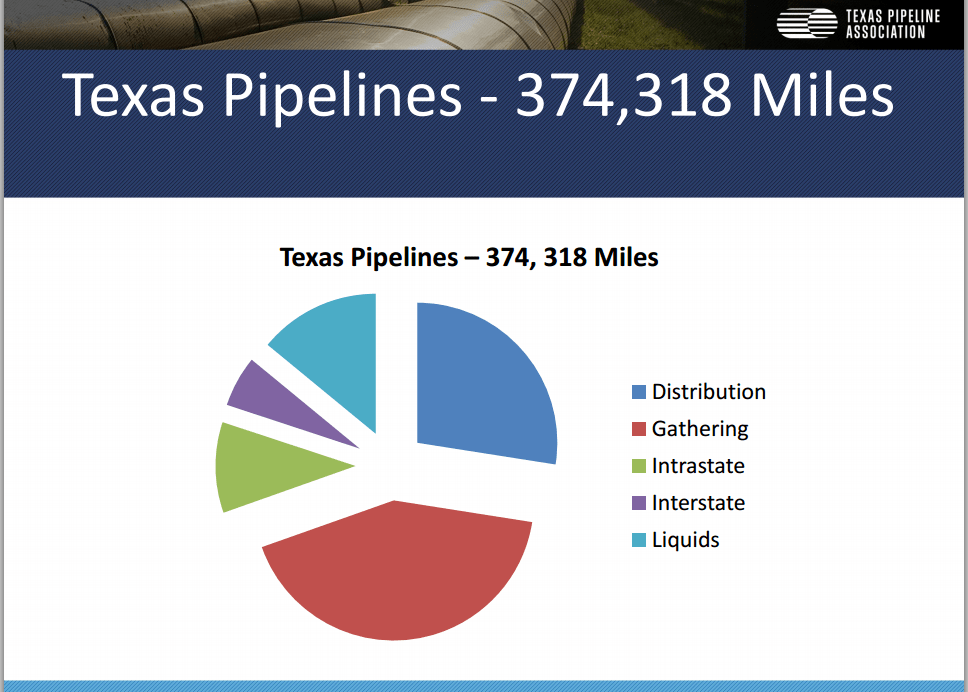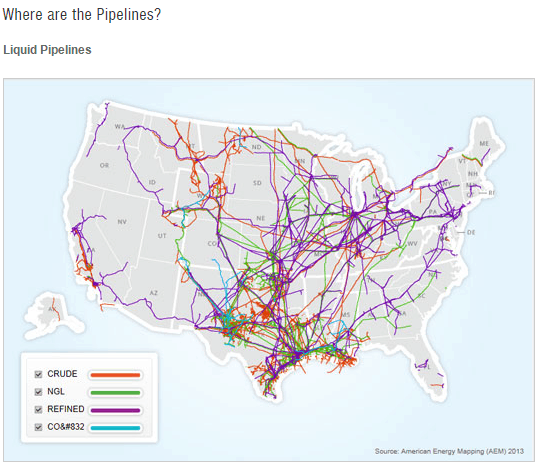When I am going through the proposal process with a client, I am trying to get as much well information as possible. This ensures that the data I pass onto the engineers I work with is as detailed as possible. The more details, the more accurate our proposal sent to the client will be. One of those important details is pipeline specifications or pipeline specs. My company needs pipeline specs for CO2, H2S and water content from our clients to ensure we get them the proper unit.
So that is what I want to blog about today. What are some of the pipeline specifications? Who sets them? And why does it even matter?

The graph above shows the different types of oil and gas pipelines just in the State of Texas.
Quick history lesson friends. Oil and gas pipelines started back in the 1800’s. The Teamsters had a strangle hold on transporting the first oil discovered. It was transported in old whiskey barrels by horse. In 1862 the first wooden pipeline, 9 miles in length, was built. The Teamsters try to stop the construction of the pipeline with sabotage, armed attacks and threats but were unsuccessful. As American technology and the industrial age boomed, so did the pipelines. Oil and gas flowed by railway and steel pipelines. Better steel was created and we discovered how to run the pipelines underground. As with so many industries, we found more economical and efficient ways to transfer oil and natural gas liquids (NGL’s) all around the country to the consumer and refineries.

I have discovered that the way a pipeline is made really depends on what will be flowing through the pipeline. Will it be crude oil, refined or unrefined? Will it be NGL’s, processed or unprocessed? These are just a fraction of the questions that companies must ask when deciding what kind of pipeline will be the safest and longest-lasting. You then have to get into fluid flow equations and formulas. These are the deciding factors engineers must use to establishing the thickness of the pipeline. It can start to get REALLY technical here, so I’m going to stop. If you want to learn more about piping codes, standards, materials used, wall thickness calculations, you get the idea, click below and read up on what PetroWiki has.
After all the reading and researching I have done, the exert below is the closest thing I could find to a documented standard for allowable amounts of H2S, CO2 or water content in a pipeline.
“Gradually, pipeline tariffs emerged, as mandated by the Federal Power Commission (FPC)*, as the vehicle to define “pipeline quality” gas and merchant standards. Tariffs were and are the documents filed by utilities with their regulatory agencies which detail their terms and conditions of service and associated prices for various classes of customers. “Pipeline quality” gas cam to be defined as natural gas (1) within +/- 5% of the heating value of pure methane or 1,010 Btu per cubic foot under standard atmospheric conditions, and (2) free of water and toxic or corrosive contaminants.” *The FPC has been replaced with the Federal Energy Regulatory Commission (FERC)
Fun fact, whoever owns the pipeline decides the pipeline specs. Now there are recommendations from organizations like the American Petroleum Institute (API). These same pipelines are inspected by the Pipeline and Hazardous Materials Safety Admnistration (PHMSA) but essentially it comes down to the owner of the pipeline. So a company getting a natural resource straight from the ground will have to meet a specification, set by individual pipeline operators, for how much water content, H2S (hydrogen sulfide), and CO2 (carbon dioxide) can stay in the liquid.
Here is where it can get tricky for my clients. If they have multiple well sites they can have completely different pipeline specs at each site. Depending on how spread out their sites are, they may be dealing with a different pipeline owner at each site. Why? Because, again, the owner of the line decides the spec. If your the well owner and you are not meeting pipeline spec, the pipeline owner can come and flip the switch and not allow you to flow into their line. Now that well owner is not making any money. Ain’t nobody got time for that.
If too much water is left in a pipeline hydrates can form. This can slow or even stop a pipeline from flowing.
If H2S and CO2 are put into a pipeline they can corrode the inside of the pipeline. Let’s add another layer to that. If you have a gathering station where smaller pipelines meet to flow into a larger pipeline, that can them move on rail transportation or to refineries, those pipelines may have another spec. So now the company managing the gathering station may have to meet new pipeline specs.
There are compression stations for these pipelines as well. As the gas moves along the line it will lose speed or velocity. The gas often needs to be compressed again to get to the end of the line for refining. Guess what……pipeline specs need to be met.
Now, there is a good chance that a lot of these different pipeline companies have the same specs or at least they are only a difference of 1-2% of allowables. Remember lots of these pipeline straddle different states so they are all trying to meet the FERC’s standards. No matter what, the persons putting the resources into the line must know what is required of them or they will lose valuable time and money.
Croft Production Systems has multiple units that can ensure your company meets pipeline specifications. Click the link below to see our main product line and learn more!
References:
http://www.pipeline101.com/the-history-of-pipelines/1800
http://petrowiki.org/PetroWiki












